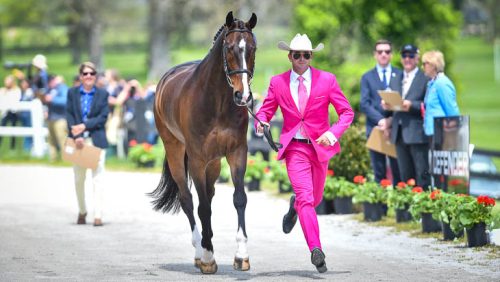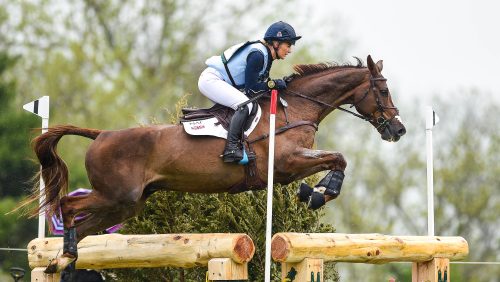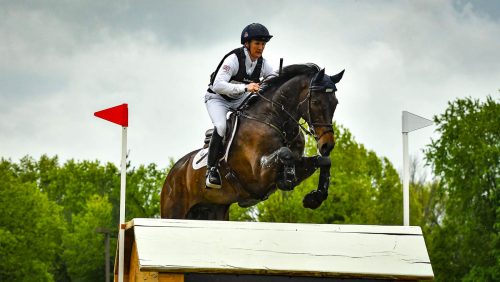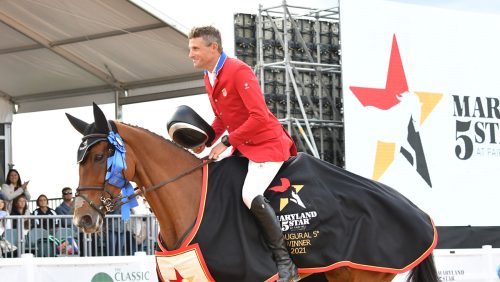A black-and-white pinto American Saddlebred walks into the dressage ring at a Sinead Halpin clinic. Sounds like the start of a corny joke, doesn’t it?
It’s not. It’s exactly what happened at Antebellum Farm in Lexington, Ky., during four-star eventer Halpin’s two-day clinic on April 16-17. (You can see my stories about the clinic for the Chronicle here.)
Brooke Schafer had signed up to ride in the clinic with her off-the-track Thoroughbred, but when that horse came up foot-sore the day Schafer was supposed to have her private dressage lesson with Halpin, she loaded up her Saddlebred, Nite Of Fame, in the trailer instead.
I was in the ring with Halpin when “Fame” and Schafer walked in, as I had been since 8 a.m. that morning. Halpin had been teaching non-stop—she started with the novice jumping group in the morning and went straight to a series of four private dressage lessons. Schafer was her last dressage session before Halpin taught three more jumping groups.
Halpin had used up her own lunch break earlier that day when she spent 20 minutes riding and schooling one of her student’s horses. It was incredible to watch and very educational for the horse and his rider, but it put Halpin behind schedule.
She wolfed down a sandwich while setting fences for her jumping lessons, and when her back started bothering her from standing in the middle of the ring all day, she sat down on a picnic table in the corner of the ring, still the picture of focus as she studied the horse and rider in front of her and honed in on the two or three simple changes that would best help them.
To say I was impressed would be an understatement. I couldn’t believe what a good sport Halpin was being about everything. On the first day of the clinic, she taught from 8 a.m. to after 6 p.m., speaking practically nonstop. She answered questions I had for my article in between sessions, answered auditor questions, and talked with parents of the riders on things their kids could work on at home.
At lunch, instead of finding somewhere quiet to sit and rest for just a few minutes, Halpin joined the clinic-goers at a picnic table and talked some more. The girls and women around her listened intently as she thoughtfully answered everyone’s questions. There were no quick yesses or nos—for example, when asked about the jump into the VIP tent at the Wellington Eventing Showcase, she explained how the turn into the tent set the horses up, how the ride in was, what it looked like inside the tent.
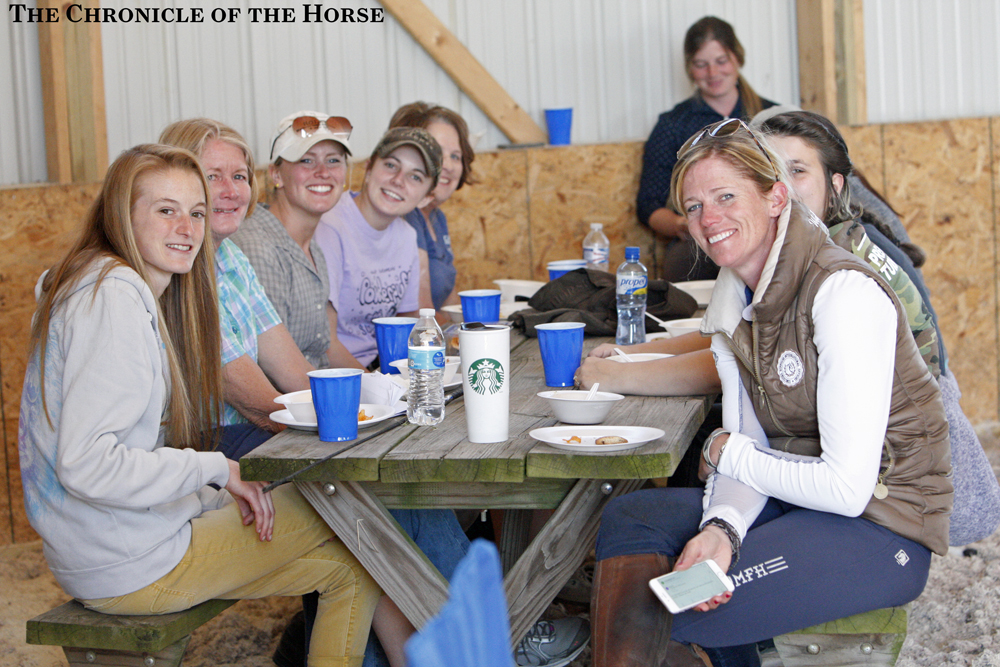
Sinead Halpin (front right) took time to have lunch with clinic participants. Photo by Ann Glavan
After a long Saturday of teaching, Halpin stayed for the clinic’s cookout and dinner party, once again parking herself at a picnic table and answering everyone’s questions, not leaving for the night until after 9 p.m.
ADVERTISEMENT
So by the time Sunday afternoon rolled around, I was already truly impressed by her approach to the clinic. I spent the entire winter working for the Chronicle in Wellington, Fla., surrounded by the circus of international show jumping riders and the pomp and circumstance that often accompanies them. I was already so impressed by the lack of nose-in-the-air, high horsery I was finding at Halpin’s clinic—rangey fresh off-the-track Thoroughbreds who had hardly jumped two feet were getting the same detailed, thoughtful instruction as upper-level horses and riders at the clinic.
Then Schafer walked in on her pinto Saddlebred, who promptly parked out in front of Halpin.
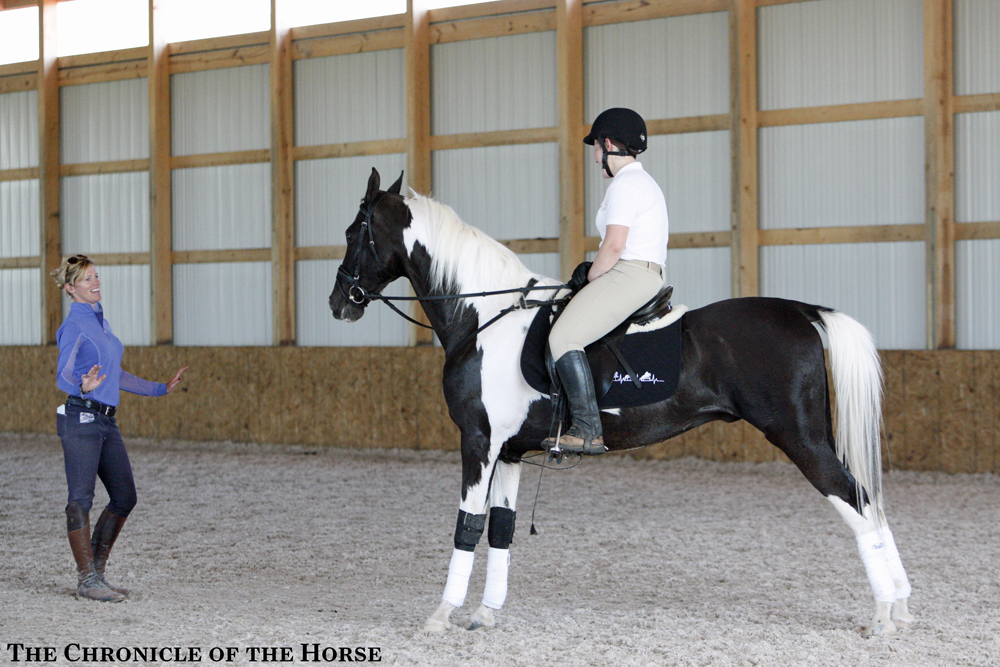
Nite of Fame showing off his park out to clinician Sinead Halpin. Photo by Ann Glavan
Now, for a disclaimer: Obviously any breed of horse can jump and compete in eventing, and in fact Fame used to. He represented his breed at the Secretariet Festival in 2014 and did a jumping display for the crowd, but Schafer said their first try at eventing Fame was a flop—jumping made him too nervous.
Now Schafer just pops him over fences for fun at home, and she mostly competes him in Saddlebred hunter classes. Schafer gave Halpin an abbreviated version of this history, including the fact that Fame’s main job is neither dressage nor eventing nowadays, but Saddlebred classes.
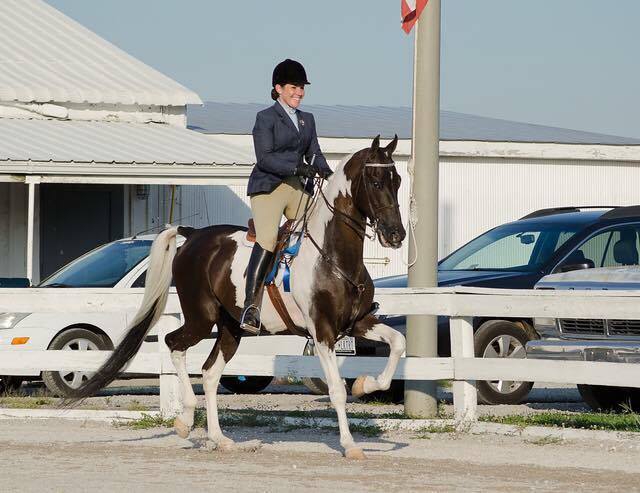
Nite of Fame and Brooke Schafer showing in a Saddlebred hunter class. Photo by Jennifer Nadine Photography
I don’t know how I expected Halpin to react to this intro or this horse, but what she said was such a perfect encapsulation of her whole attitude at the clinic. “He’s adorable! He’s black and white, my cross-country colors—I love it!” She listened to the horse’s story and asked Schafer to ride him around so she could get a sense for his usual warm-up, just like she had for every other rider.
Then she got up from the table and began working with Schafer to coax a better trot-canter transition out of the horse, how to ride him straight with the aids so his head wasn’t craned in to the inside, how to open and close his stride.
It was an awesome lesson to watch. Halpin took this wide-eyed horse who was going around the ring quick and tense and running into the canter, and she instructed Schafer on how to collect and compress his trot before asking for the canter, and how to move his haunches around at the trot to get more engagement.
Sinead Halpin helping Brooke Schafer work on Nite of Fame’s trot. Photo by Ann Glavan
ADVERTISEMENT

Halpin ended the lesson by congratulating Schafer on two particularly good trot-canter transitions, giving Fame a pat, and saying he reminded her of a “magical, mythical creature.” She laughed as the horse gave a big sigh and parked out after the tough lesson.
Fame was not the horse I thought I would learn the most from at that clinic. I thought I’d watch the upper-level horses jump and get advice on the training and schooling it took to get there. I thought I’d watch the young Thoroughbreds go and pick up some pointers on how to start them. I did see those things, and I did store that information away for use in my own riding.
But the lesson that will really stick with me for a long time from this clinic is that pinto Saddlebred, and how Halpin helped him and Schafer, and her reaction to him walking into her clinic ring.
I spent the whole winter watching top international riders compete and train, but it was that moment that really solidified in my mind how applicable the principles of good riding are—how the same things that will help Sinead Halpin ride a four-star dressage test are going to help a little pinto Saddlebred trying to get a clean trot-canter transition. Good riding is good riding, and good teaching is good teaching.
It’s so easy to watch the show jumpers jump a five-star track, or see the eventers fly around a four-star cross-country course, and think of them as other-worldly, completely separate from us lowly amateurs and our modest riding goals. You circle different suns. I want to make it around my three-foot hunter course at my next locally rated show without eating it at the single oxer; Halpin wants to win the biggest three-day event in the United States.
But then a Saddlebred walks into the ring at a Sinead Halpin clinic, you see those two worlds intersect, and you realize there is truly something of value that comes out of that interaction.
Fame the Saddlebred will never trot down centerline in a four-star test, but the straightness and the collection and the transition work Halpin put him through is just as helpful and beneficial to him and Schafer as it is to her and Manoir de Carneville. Fame and Halpin’s competitive worlds will never overlap or intersect, but the principles they use are one and the same. There is a massive spectrum of talent and ability and competition goals among horses and riders out there, but the same basic principles can help them all.
I’ve heard trainers say that all my life, but it took a high-stepping horse and Halpin to really illustrate and drive it home.







